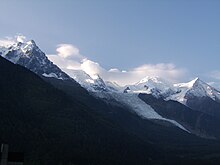| Revision as of 07:54, 5 September 2008 edit213.48.183.82 (talk)No edit summary← Previous edit | Revision as of 14:24, 5 September 2008 edit undoWadewitz (talk | contribs)50,892 edits removing unsourced materialNext edit → | ||
| Line 6: | Line 6: | ||
| According to Romanticism scholar Duncan Wu, the poem is "Shelley's exploration of the nature of imaginative thought, and its relation to the nature world".<ref name=Wu>"Mont Blanc", ''Romanticism: An Anthology'', 2nd ed., Ed. Duncan Wu, Oxford: Blackwell (1998), 845, note 1.</ref> It is a response to ] poem on the same topic, '']'' and a "defiant reaction" against the "religious certainties" of ] '']'',<ref name=Wu/> which "credits God for the sublime wonders of the landscape".<ref name=Reiman/> | According to Romanticism scholar Duncan Wu, the poem is "Shelley's exploration of the nature of imaginative thought, and its relation to the nature world".<ref name=Wu>"Mont Blanc", ''Romanticism: An Anthology'', 2nd ed., Ed. Duncan Wu, Oxford: Blackwell (1998), 845, note 1.</ref> It is a response to ] poem on the same topic, '']'' and a "defiant reaction" against the "religious certainties" of ] '']'',<ref name=Wu/> which "credits God for the sublime wonders of the landscape".<ref name=Reiman/> | ||
| A sculpture entitled ] and inspired by the Mont Blanc poem is in ] town centre. It was designed by Angela Conner and features a rush of water every five minutes | |||
| ==Notes== | ==Notes== | ||
Revision as of 14:24, 5 September 2008

Mont Blanc: Lines Written in the Vale of Chamouni is a poem by the Romantic poet Percy Bysshe Shelley composed between 22 July 1816 and 29 August 1816. It was first published in 1817 in History of a Six Weeks' Tour through a Part of France, Switzerland, German and Holland by Percy Shelley and Mary Shelley.
"Mont Blanc" was written when Mary Godwin, Percy Shelley, and Claire Clairmont (Mary Godwin's half-sister by marriage), were touring the Chamonix Valley and visited Mont Blanc, Europe's highest mountain. The setting of the poem and the place Shelley was inspired to write the poem is a bridge over the Arve River in the Valley of Chamonix in Savoy, near Geneva. Mary Shelley wrote that the poem "was composed under the immediate impression of the deep and powerful feelings excited by the objects which it attempts to describe; and, as an undisciplined overflowing of the soul, rests its claim to approbation on an attempt to imitate the untamable wilderness and inaccessible solemnity from which those feeling sprang".
According to Romanticism scholar Duncan Wu, the poem is "Shelley's exploration of the nature of imaginative thought, and its relation to the nature world". It is a response to William Wordsworth's poem on the same topic, Tintern Abbey and a "defiant reaction" against the "religious certainties" of Samuel Taylor Coleridge's Chamouny, which "credits God for the sublime wonders of the landscape".
Notes
- ^ "Mont Blanc", Shelley's Prose and Poetry, 2nd ed., Ed. Donald H. Reiman and Neil Fraistat, New York: Norton and Co. (2002), 96.
- ^ "Mont Blanc", Romanticism: An Anthology, 2nd ed., Ed. Duncan Wu, Oxford: Blackwell (1998), 845, note 1.